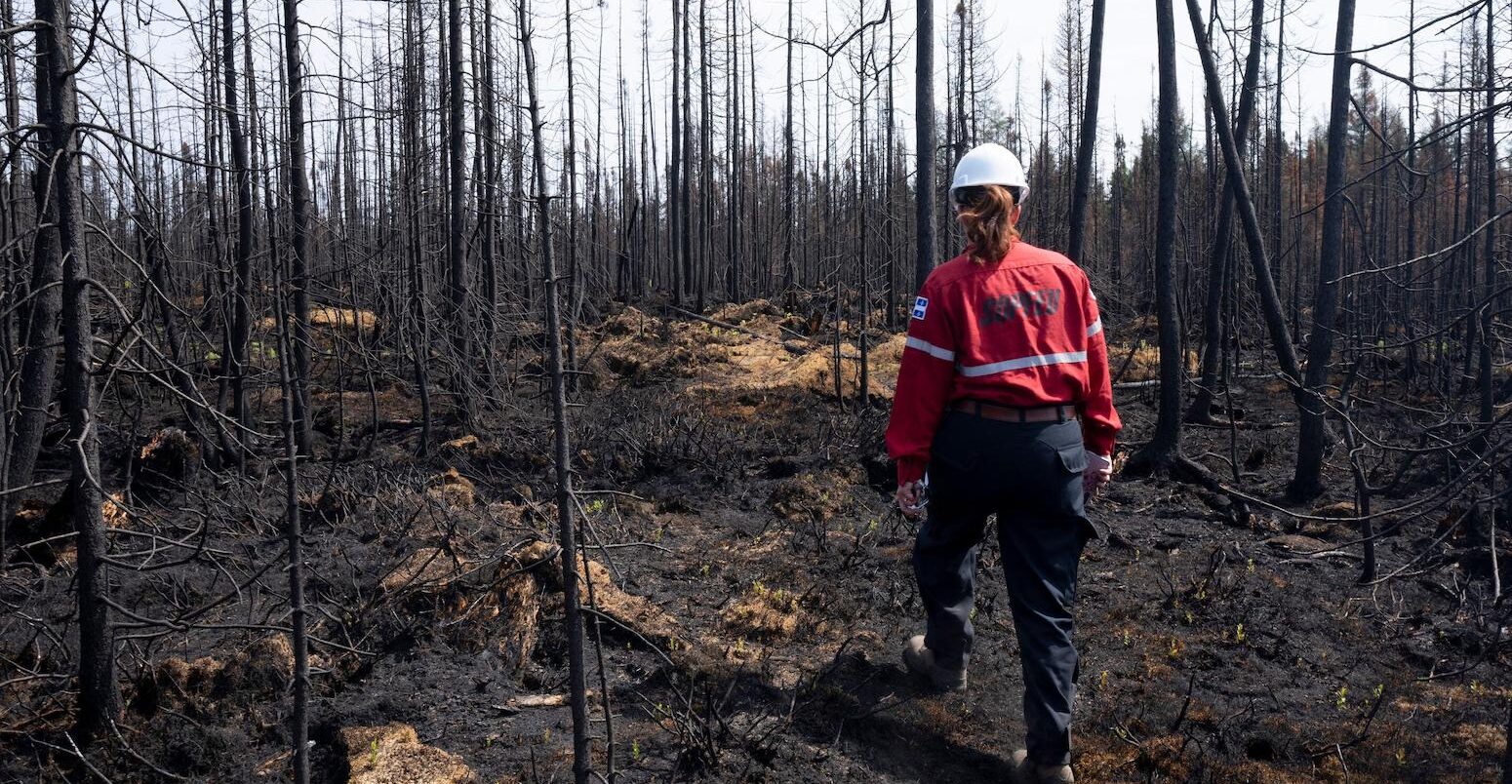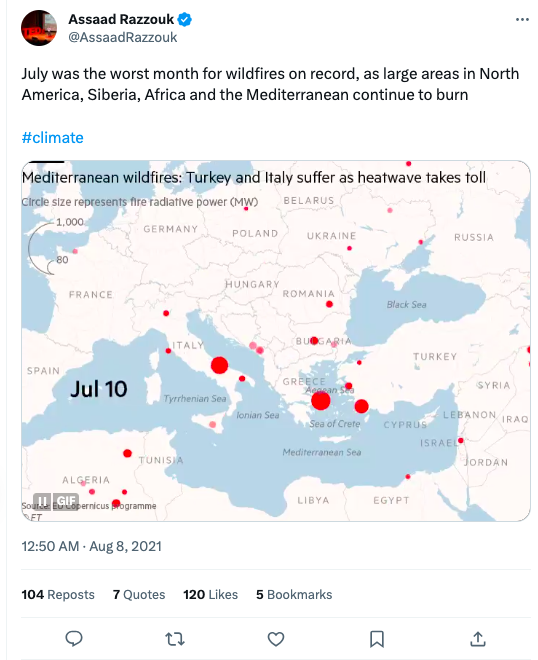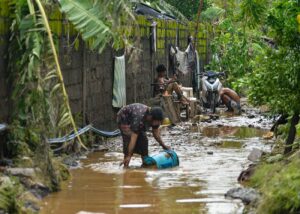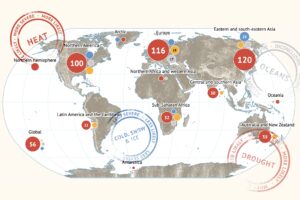
Eastern Canada wildfires: Climate change doubled likelihood of ‘extreme fire weather’
Ayesha Tandon
08.22.23Ayesha Tandon
22.08.2023 | 8:00pmThe unusually hot and dry weather that drove record-breaking wildfires in eastern Canada was made at least two times more likely by human-caused climate change, according to a new rapid attribution study.
Canada is experiencing its most severe wildfire season in recorded history this year. Wildfires have burned more than 15m hectares (12 acres) of land, forcing thousands of people to evacuate and sending up billowing plumes of smoke that have reached as far as New York.
Around 4% of Canada’s total forest area has burned this year. The wildfires have already doubled the previous records for burned area and carbon emissions, and the wildfire season is not over yet. There are more than 1,000 active fires nationwide, two-thirds of which are classed as out of control.
“The word ‘unprecedented’ doesn’t do justice to the severity of the wildfires in Canada this year,” an author on the study warns. He adds that “from a scientific perspective, the doubling of the previous burned area record is shocking”.
The “unusually” hot and dry weather conditions were important drivers of the unprecedented wildfires, the World Weather Attribution service finds.
The “peak fire weather” seen in eastern Canada over May-July this year was at least two times more likely and 20% more intense due to human-induced climate change, the study finds. It warns that as the climate warms, “fire-prone weather” will become more likely.
‘Unprecedented’ wildfires
In the summer of 2023, all seven of Earth’s continents experienced record-breaking climate extremes. The first week of July was the planet’s hottest week on record, and saw countries across the northern hemisphere grapple with record-breaking heat.
Intense heat can cause vegetation to dry out, creating ideal conditions for wildfires to ignite and spread. Amid the record-breaking heat, many countries across the northern hemisphere have seen unprecedented wildfires this summer.
In July 2023, wildfires broke out across the Mediterranean amid record-breaking heat. In just 12 days, 135,000 hectares of land burned across southern Europe.
A state of emergency was declared across the entire island of Rhodes in Greece after nearly 20,000 people – mainly tourists – were forced to evacuate in a single day. The operation was described as the biggest evacuation ever carried out in Greece. Across Greece, wildfires are still burning out of control.
On the other side of the Mediterranean, swathes of Algeria’s coastline were engulfed in flames which forced more than 1,500 households to evacuate, cut power from 1,700 homes and killed more than 30 people. The blazes also spread to neighbouring Tunisia, which was seeing temperatures peaks of 49C.
And across the Atlantic, Canada is experiencing its most severe wildfire season in recorded history this year. Unprecedented and uncontrollable wildfires have also been sweeping across the country for months.
The month of May this year was Canada’s warmest and seventh-driest since at least 1940, kicking off an earlier-than-usual start to the wildfire season. Hundreds of wildfires quickly began to spread across the country, forcing tens of thousands of people to evacuate their homes.
Dr Piyush Jain from Canada’s Northern Forestry Centre, who was not involved in the study, tells Carbon Brief it is “remarkable” that fires began so early in the season and in so many regions simultaneously.
For example, he says that in Alberta, the majority of the burning happened during the “spring window” – a period after the snow melts but before leaves form on trees, when forests are particularly vulnerable to wildfire ignition and spread.
On 25 June, the Canadian Interagency Forest Fire Centre announced that the 2023 wildfire season had already topped the charts with the largest annual burned area in the country’s recorded history.
Billowing plumes of smoke from Canada blew to the US, where the air quality plummeted. Residents of New York, Philadelphia and Washington DC were advised to stay inside as the sky turned orange.
By mid-July, wildfires in Canada had already burned more than 10m hectares (25m acres), shattering the country’s previous annual record of 7m hectares, set in 1989.
Fires are still burning across the country. To date, around 6,000 wildfires have burned 15m hectares (37m acres) of land – about 4% of the entire forest area of Canada and more than six times the long-term average for the time of year. There are still more than 1,000 active wildfires nationwide, two-thirds of which are “out of control”.
Dr Yan Boulanger – a research scientist at Natural Resources Canada and co-author on the study – says “the word ‘unprecedented’ doesn’t do justice to the severity of the wildfires in Canada this year”. Boulanger adds that “from a scientific perspective, the doubling of the previous burned area record is shocking”.
During a press briefing, he told journalists that this year has seen Canada’s “most devastating fire season in recent memory by far”.
Fire weather
Wildfires duration and severity are influenced by a wide range of factors, including weather, vegetation type and fire management strategy.
Dr Clair Barnes is a research associate at the Grantham Institute for Climate Change and the Environment at Imperial College London and author on the study. She explains that wildfires are “more complicated to study” than many other extreme weather events, thanks to the “unique characteristics of fire weather in different regions of the world”.
However, she adds:
“From the limited number of studies available, it’s becoming evident that the dry and warm conditions conducive to wildfires are becoming more common and more intense around the world as a result of climate change.”
These conditions are often called “fire weather”. The study investigates the impact of climate change on fire weather in eastern Canada, where there was an “unusually active fire season” in 2023.
To assess the severity of Canada’s wildfire season, the authors use the “fire weather index” – a meteorological index incorporating temperature, relative humidity, wind speed and rainfall. They calculate the annual maximum of the seven-day average fire weather index to capture the peak intensity of the fire season.
Then also assess “daily severity rating” – a measure reflecting how difficult a fire is to suppress once it begins to burn, which is typically used for assessing fire weather on monthly or longer timescales.
The map below shows active fires within Canada over January-July 2023 with black dots, grey diamonds indicate smaller fires. Shading indicates the “cumulative severity rating”, with darker colours indicating hot and dry weather that makes fires harder to put out. The study region is outlined in blue.

Attribution
Attribution is a fast-growing field of climate science that aims to identify the “fingerprint” of climate change on extreme-weather events. To conduct attribution studies, scientists use models to compare the world as it is today to a “counterfactual” world without human-caused climate change.
To put the wildfires season into its historical context and determine how unlikely it was, the authors analysed a timeseries of both seven-day maximum fire weather index and cumulative daily severity rating over May-July 2023 in eastern Canada.
Although the fire-prone weather conditions were “exceptionally extreme”, they are “no longer extremely unusual”, the study says. The authors find that in today’s climate, Canada’s 2023 wildfire season is a “moderately extreme event” that is expected to occur only once every 20-25 years.
The study also finds that if the planet continues to warm, the risk of even greater wildfires will further increase.
Climate change made the “cumulative severity” of eastern Canada’s 2023 fire season around 50% more intense, the study finds. It adds that wildfire seasons of this severity are at least seven times more likely to occur due to climate change.
The authors also find that “peak fire weather” – measured using the annual seven-day maximum of fire weather intensity – akin to that experienced in Canada this year is at least twice as likely and 20% more intense due to human-induced climate change.
(These findings are yet to be published in a peer-reviewed journal. However, the methods used in the analysis have been published in previous attribution studies.)
Dr Frederieke Otto is a senior lecturer in climate science at the Grantham Institute for Climate Change and the Environment at Imperial College London and co-author of the study. (Otto is also a Carbon Brief contributing editor.) She told the press briefing that due to the complexity of fire weather, there is a large spread of possible results in the study.
Otto explained that the authors chose to report the “conservative” end of the results, which the authors have the most confidence in. However, she says the role of climate change on Canada’s wildfires may be higher than the values reported in the study.
-
Eastern Canada wildfires: Climate change doubled likelihood of ‘extreme fire weather’







